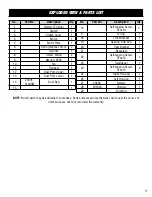
13
OPERATION
WORKPIECE AND WORK AREA SET UP
1. Designate a work area that is clean and well-lit. The work area must not allow access by children or pets to prevent
distraction and injury. We know your cat is super cute, but pay attention to your project.
2. Secure loose workpieces using vises or clamps (not included) to prevent movement while working.
3. Move all objects that could pose as a possible hazard away from the work area.
GENERAL OPERATING INSTRUCTIONS
1. Make sure that the power switch is in the OFF position.
2. Turn the switch to the ON position.
3. Do not use excess pressure while sanding. Always sand in same direction as the grain of the wood. Let the sand-
paper do the work. Apply even pressure over the entire workpiece.
4. Check the wear on the sandpaper at regular intervals and replace as necessary.
NOTE:
Always turn the switch OFF and remove the battery from the sander before changing sheets of sandpaper.
5. When sanding is competed, remove the sander from the workpiece and turn the power switch to the OFF position.
6. When completely finished using the sander, empty the dust bag, then use a vacuum to remove any dust from the
dust bag port.
7. To prevent accidents, turn off the sander after use, clean it, remove the battery, and then store the sander indoors
out of children’s reach.
SANDPAPER SELECTION
Choosing the right grit and material of sandpaper maximizes the quality of your sanded finish. Aluminum oxide, sili-
con carbide, and other synthetic abrasives are best for power sanding as natural abrasives, such as flint and garnet,
are too soft for economical use in power sanding.
In general, coarse grit (lower numbers) will remove the most material and finer grit (higher numbers) will produce
the best finish in all sanding operations. The condition of the surface to be sanded will determine the right grit for
the job. If the surface is rough, start with a coarse grit and sand until the surface is uniform. Medium grit may then
be used to remove the scratches left by the coarser grit while a finer grit can be used for finishing. Always continue
sanding with each grit until the surface is uniform.
NOTE:
DO NOT use the sander without sandpaper. Doing so will damage the hook and loop fastener sanding base.
Summary of Contents for 20401
Page 19: ...19 NOTES ...






































